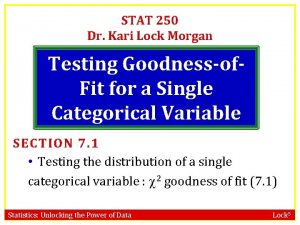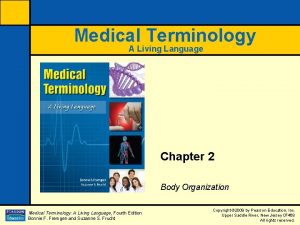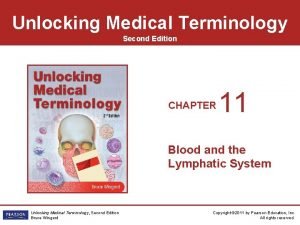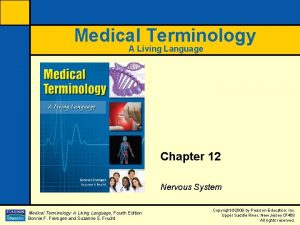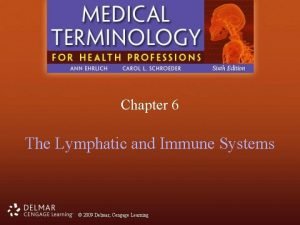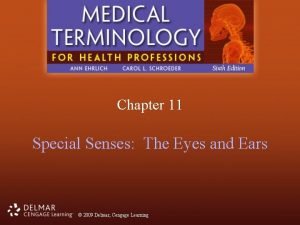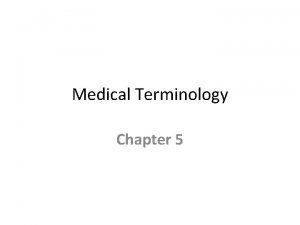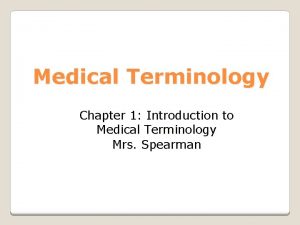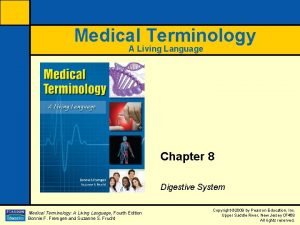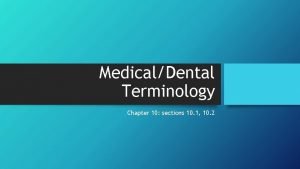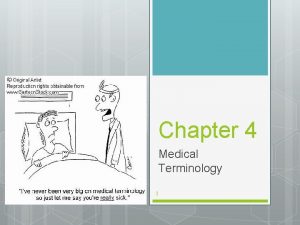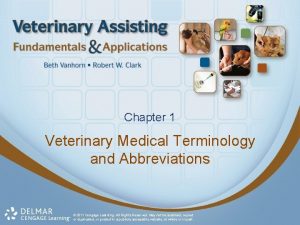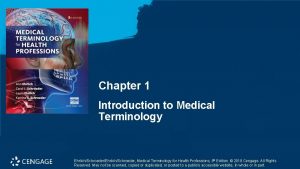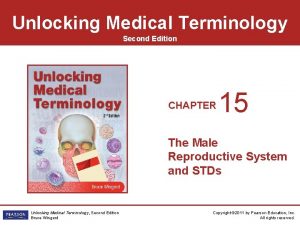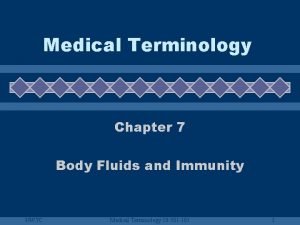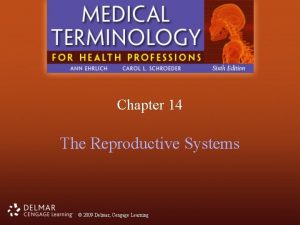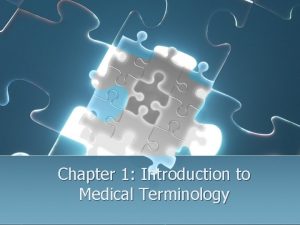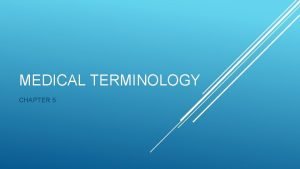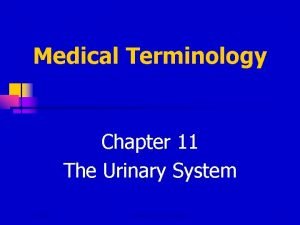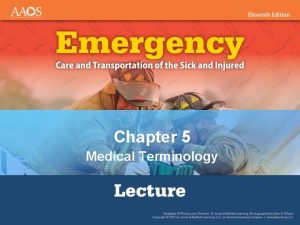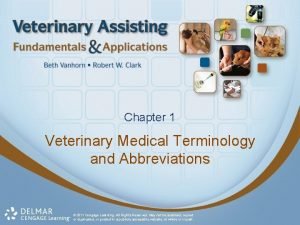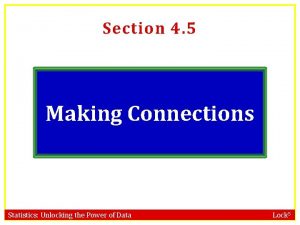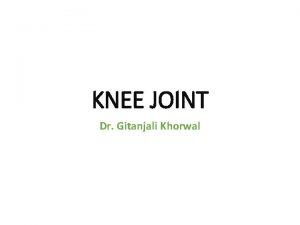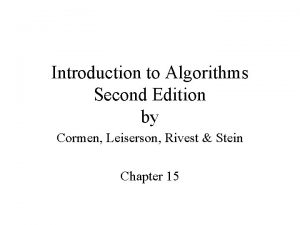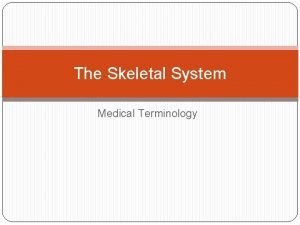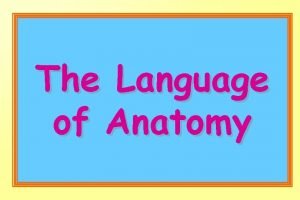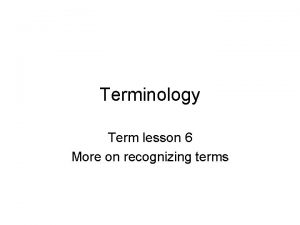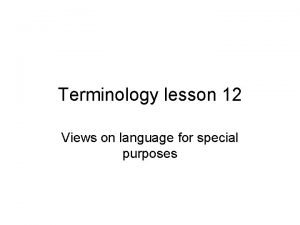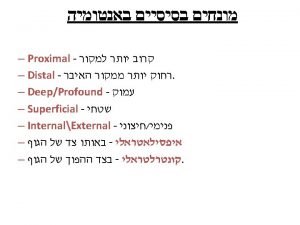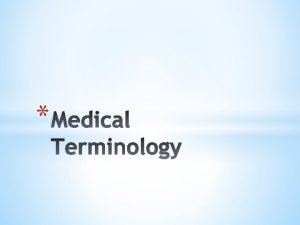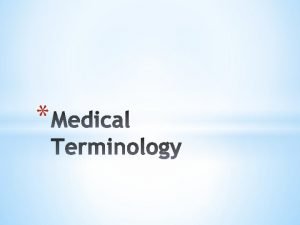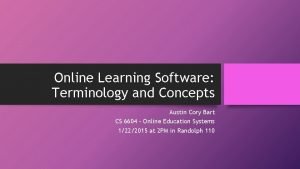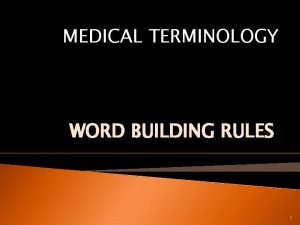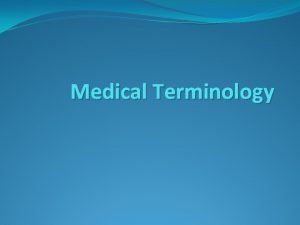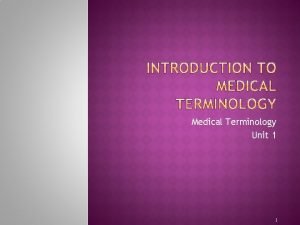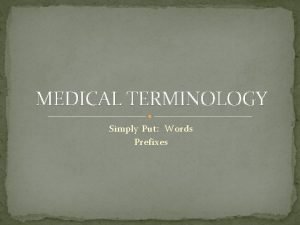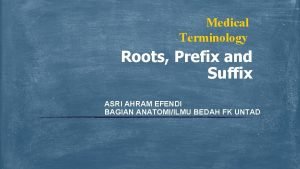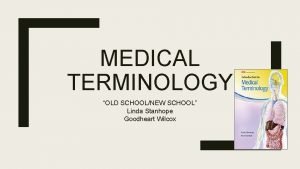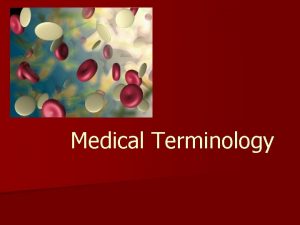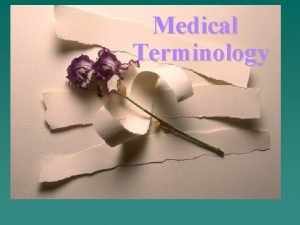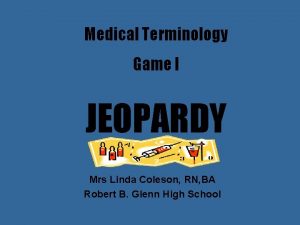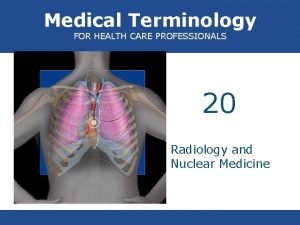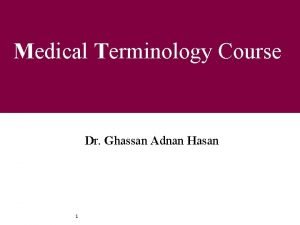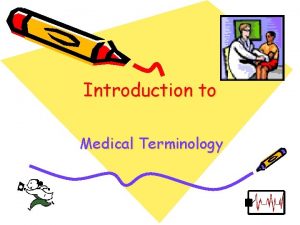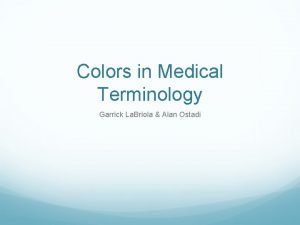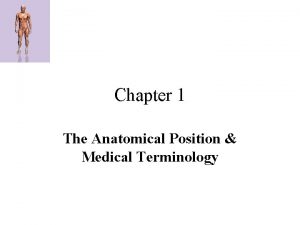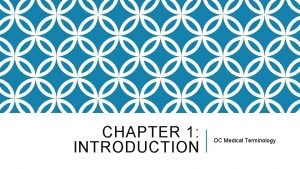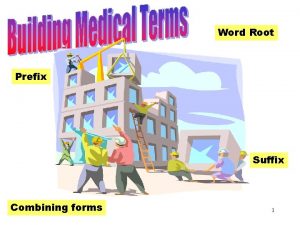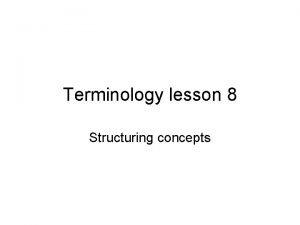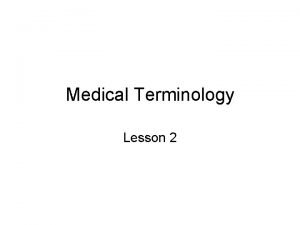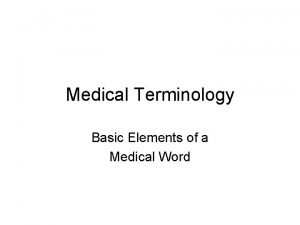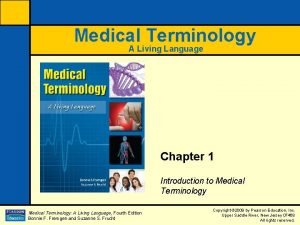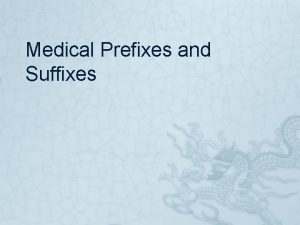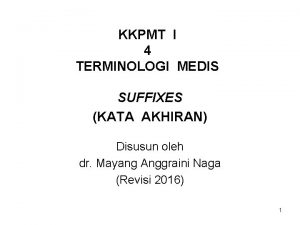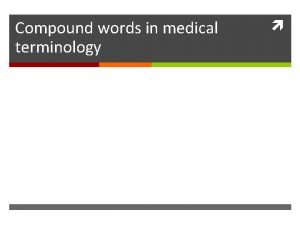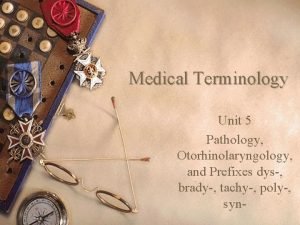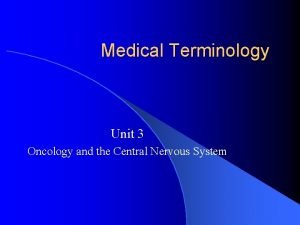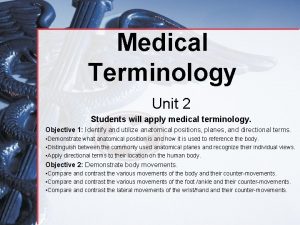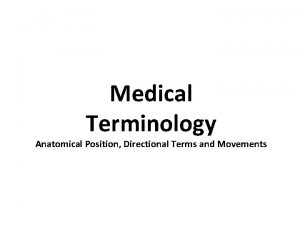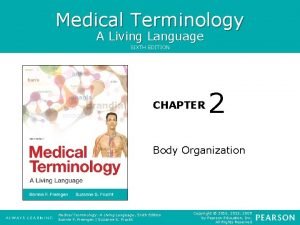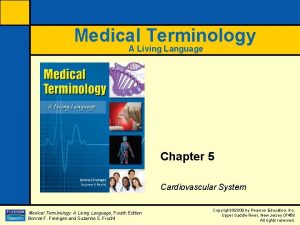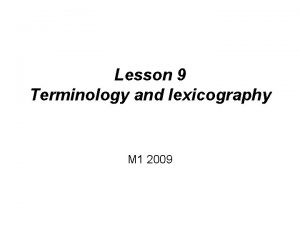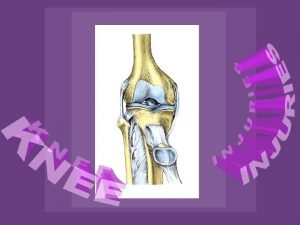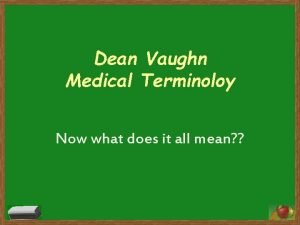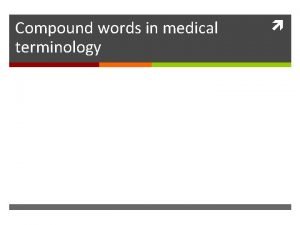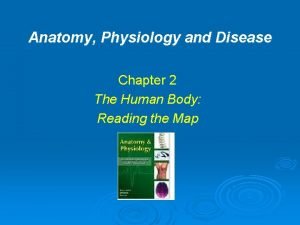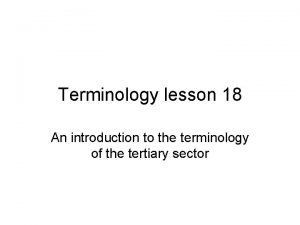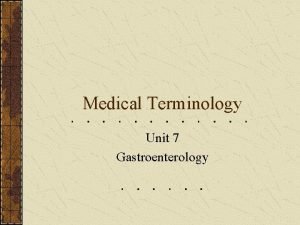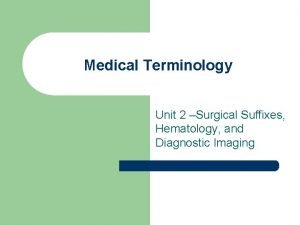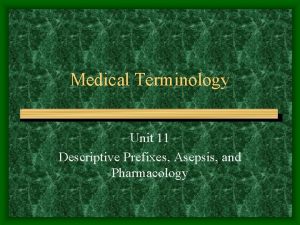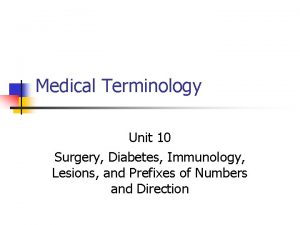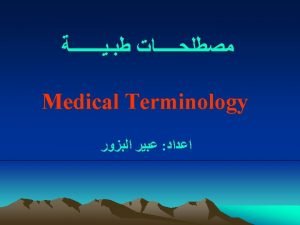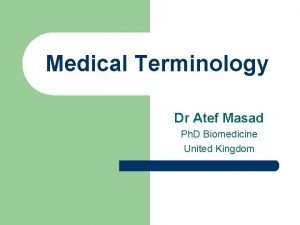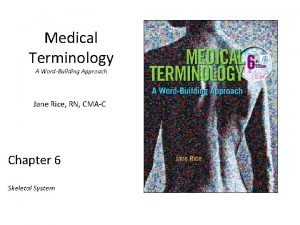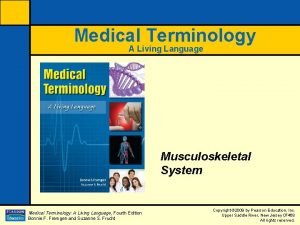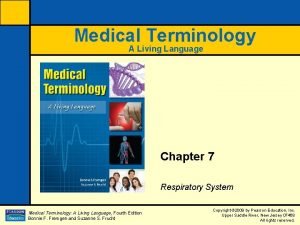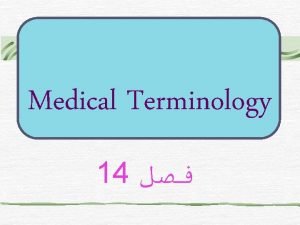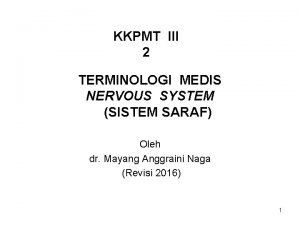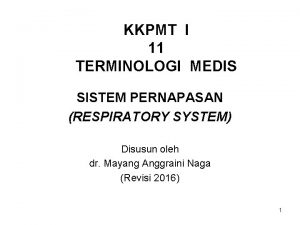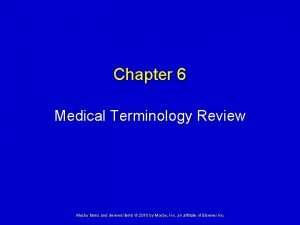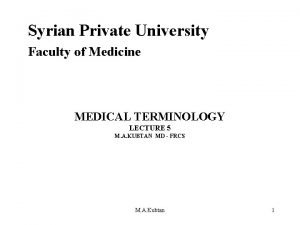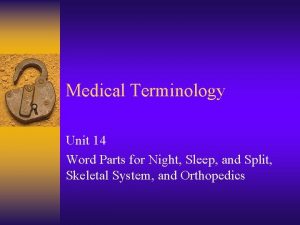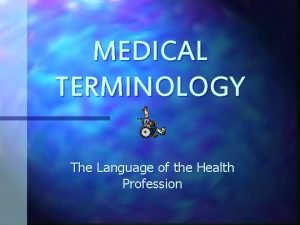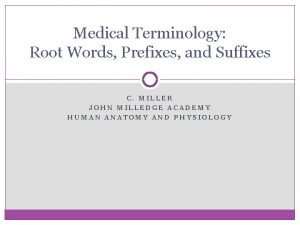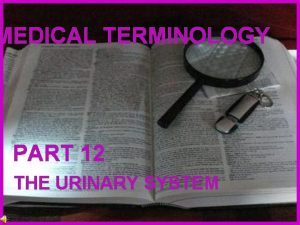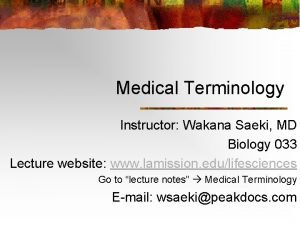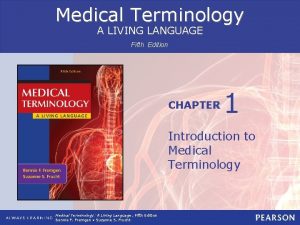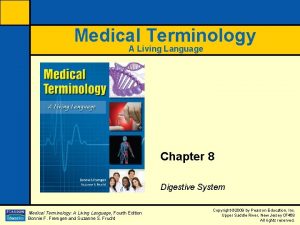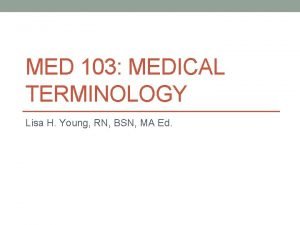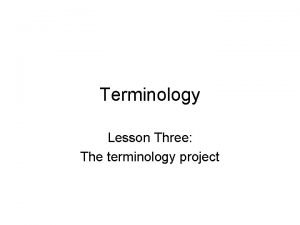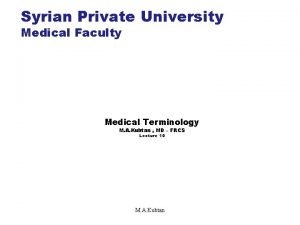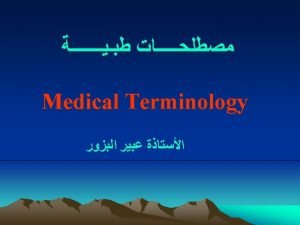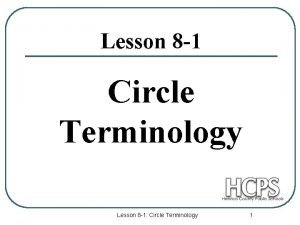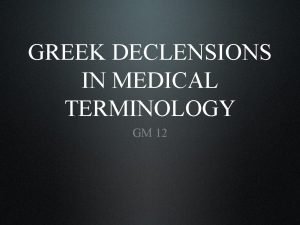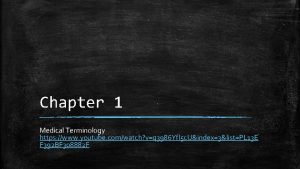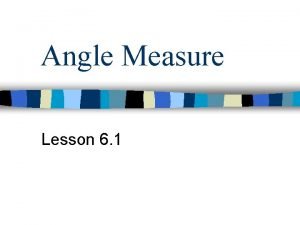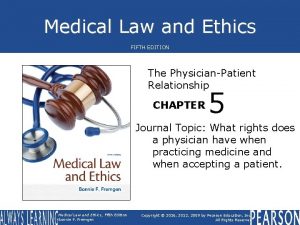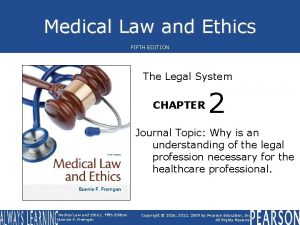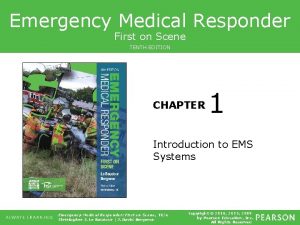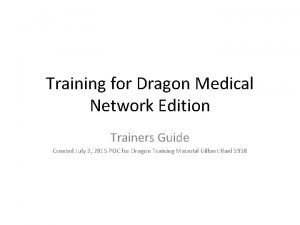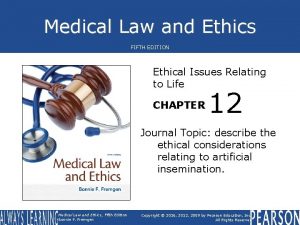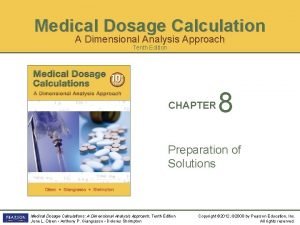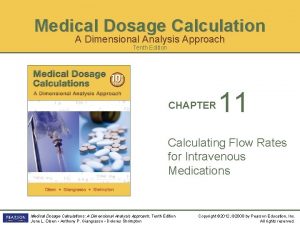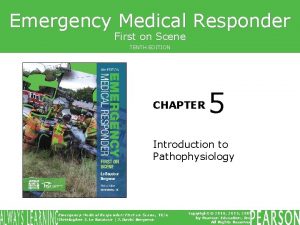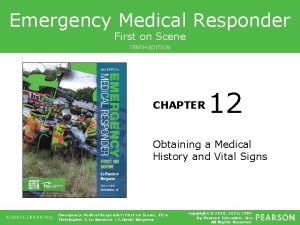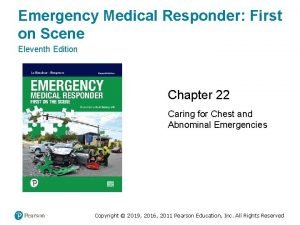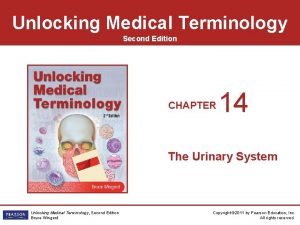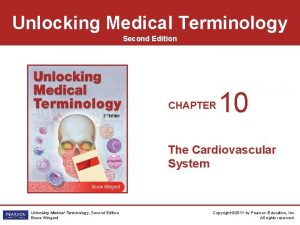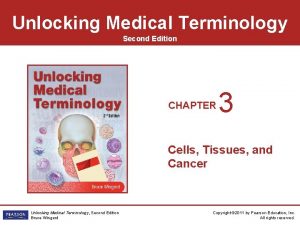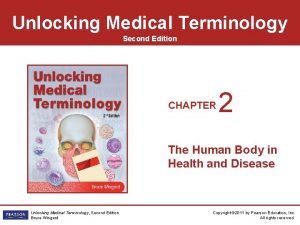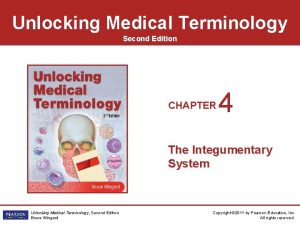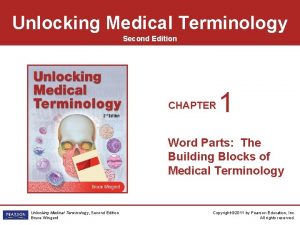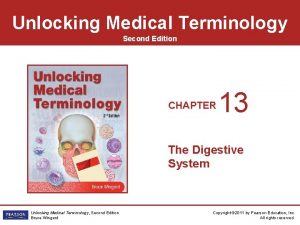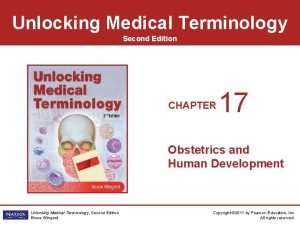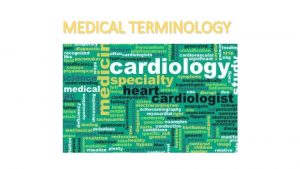Unlocking Medical Terminology Second Edition CHAPTER 6 The







































































































































































- Slides: 167

Unlocking Medical Terminology Second Edition CHAPTER 6 The Nervous System and Mental Health Unlocking Medical Terminology, Second Edition Bruce Wingerd Copyright © 2011 by Pearson Education, Inc. All rights reserved.

Multimedia Directory Slide 41 Slide 57 Slide 69 Slide 81 Slide 86 Slide 92 Slide 93 Slide 94 Slide 98 Slide 100 Slide 102 Slide 103 Brain and Brainstem Animation Alzheimer's Video Epilepsy Video Multiple Sclerosis Animation Parkinson's Disease Video Seizures Animation Febrile Seizures Animation Anorexia Video ADD Video Bipolar Video Bulimia Video Unlocking Medical Terminology, Second Edition Bruce Wingerd Copyright © 2011 by Pearson Education, Inc. All rights reserved.

Multimedia Directory (cont. ) Slide 106 Slide 110 OCD Video Schizophrenia Video Unlocking Medical Terminology, Second Edition Bruce Wingerd Copyright © 2011 by Pearson Education, Inc. All rights reserved.

Learning Objectives After completing this chapter, you will be able to: – Define and spell the word parts used to create terms for the nervous system and mental health – Identify the major organs of the nervous system and describe their structure and function Unlocking Medical Terminology, Second Edition Bruce Wingerd Copyright © 2011 by Pearson Education, Inc. All rights reserved.

Learning Objectives (cont. ) After completing this chapter, you will be able to: – Break down and define common medical terms used for symptoms, diseases, disorders, procedures, treatments, and devices associated with the nervous system and mental health – Build medical terms from the word parts associated with the nervous system and mental health Unlocking Medical Terminology, Second Edition Bruce Wingerd Copyright © 2011 by Pearson Education, Inc. All rights reserved.

Learning Objectives (cont. ) After completing this chapter, you will be able to: – Pronounce and spell common medical terms associated with the nervous system and mental health Unlocking Medical Terminology, Second Edition Bruce Wingerd Copyright © 2011 by Pearson Education, Inc. All rights reserved.

The Nervous System • Composed of the brain, spinal cord, and nerves • These organs enable you to – sense the world around you – form thoughts and memories – control your body movements and many internal functions Unlocking Medical Terminology, Second Edition Bruce Wingerd Copyright © 2011 by Pearson Education, Inc. All rights reserved.

Prefixes • • a- = without, absence of de- = not di- = double dys- = bad, abnormal, painful, difficult Unlocking Medical Terminology, Second Edition Bruce Wingerd Copyright © 2011 by Pearson Education, Inc. All rights reserved.

Prefixes (cont. ) • hemi- = one-half • hyper- = excessive, abnormally high, above • mono- = one Unlocking Medical Terminology, Second Edition Bruce Wingerd Copyright © 2011 by Pearson Education, Inc. All rights reserved.

Prefixes (cont. ) • pan- = all, entire • par-, para- = near, alongside, departure from normal • poly- = many • pre- = before • sub- = below, beneath • tetra- = four Unlocking Medical Terminology, Second Edition Bruce Wingerd Copyright © 2011 by Pearson Education, Inc. All rights reserved.

Combining Forms • • alges/o = pain angi/o = blood vessel arachn/o = spider arteri/o = artery Unlocking Medical Terminology, Second Edition Bruce Wingerd Copyright © 2011 by Pearson Education, Inc. All rights reserved.

Combining Forms (cont. ) • • ather/o = fatty substance cephal/o = head cerebell/o = little brain, cerebellum cerebr/o = brain, cerebrum Unlocking Medical Terminology, Second Edition Bruce Wingerd Copyright © 2011 by Pearson Education, Inc. All rights reserved.

Combining Forms (cont. ) • • cran/o, crani/o = cranium dur/o = hard embol/o = a plug encephal/o = brain Unlocking Medical Terminology, Second Edition Bruce Wingerd Copyright © 2011 by Pearson Education, Inc. All rights reserved.

Combining Forms (cont. ) • • gangli/o, ganglion/o = knot, swelling gli/o = glue, neuroglia gnos/o = knowledge lumb/o = loin, lower back Unlocking Medical Terminology, Second Edition Bruce Wingerd Copyright © 2011 by Pearson Education, Inc. All rights reserved.

Combining Forms (cont. ) • • lys/o = break apart, dissolution mening/i, mening/o = membrane ment/o = mind myel/o = spinal cord, medulla, myelin sheath; bone marrow Unlocking Medical Terminology, Second Edition Bruce Wingerd Copyright © 2011 by Pearson Education, Inc. All rights reserved.

Combining Forms (cont. ) • • narc/o = numbness neur/o = sinew or cord, nerve; fascia phas/o, phasi/o = speech plegi/o = paralysis Unlocking Medical Terminology, Second Edition Bruce Wingerd Copyright © 2011 by Pearson Education, Inc. All rights reserved.

Combining Forms (cont. ) • • poli/o = gray psych/o = mind quadr/i, quadr/o = four radic/o, radicul/o = nerve root Unlocking Medical Terminology, Second Edition Bruce Wingerd Copyright © 2011 by Pearson Education, Inc. All rights reserved.

Combining Forms (cont. ) • • • scler/o = thick, hard, sclera somat/o = body spin/o = spine, thorn thalam/o = inner chamber, thalamus thromb/o = clot vascul/o = small blood vessel Unlocking Medical Terminology, Second Edition Bruce Wingerd Copyright © 2011 by Pearson Education, Inc. All rights reserved.

Suffixes • • • -algia = pain -asthenia = weakness -cele = hernia, swelling, protrusion -esthesia = sensation, perception -gram = a record Unlocking Medical Terminology, Second Edition Bruce Wingerd Copyright © 2011 by Pearson Education, Inc. All rights reserved.

Suffixes (cont. ) • • • -iatry = treatment, specialty -ic = pertaining to -ism = condition of -itis = inflammation -lepsy = seizure Unlocking Medical Terminology, Second Edition Bruce Wingerd Copyright © 2011 by Pearson Education, Inc. All rights reserved.

Suffixes (cont. ) • • • -logist = one who studies -lysis = to loosen, dissolve -malacia = softening -oid = resembling -paresis = paralysis (minor) Unlocking Medical Terminology, Second Edition Bruce Wingerd Copyright © 2011 by Pearson Education, Inc. All rights reserved.

Suffixes (cont. ) • -phagia = eating or swallowing • -phasia = speaking (may also be used as a root, phas) • -plegia = paralysis (major) • -troph = nourishment, development • -us = pertaining to Unlocking Medical Terminology, Second Edition Bruce Wingerd Copyright © 2011 by Pearson Education, Inc. All rights reserved.

Anatomy and Physiology • The nervous system provides a system of communication between the brain and distant parts of the body • Goal of nervous system is to – interpret changes in the environment inside and outside the body – initiate responses in order to maintain homeostasis – send electrochemical messages called nerve impulses Unlocking Medical Terminology, Second Edition Bruce Wingerd Copyright © 2011 by Pearson Education, Inc. All rights reserved.

Divisions of the Nervous System • The nervous system is divided into two main groups – Central nervous system (CNS) § Includes the brain and spinal cord – Peripheral nervous system (PNS) § Includes the nerves and sensory receptors Unlocking Medical Terminology, Second Edition Bruce Wingerd Copyright © 2011 by Pearson Education, Inc. All rights reserved.

Figure 6. 1 Organization of the nervous system Unlocking Medical Terminology, Second Edition Bruce Wingerd Copyright © 2011 by Pearson Education, Inc. All rights reserved.

Nervous Tissue • The nervous system contains specialized tissue that conducts nerve impulses • The impulse-conducting cells are called neurons; they receive support from nearby neuroglial cells Unlocking Medical Terminology, Second Edition Bruce Wingerd Copyright © 2011 by Pearson Education, Inc. All rights reserved.

Nervous Tissue (cont. ) • Each neuron consists of a cell body and numerous dendrites – The cell body contains the nucleus and most of the cytoplasm – Dendrites carry impulses toward the cell body, and a single axon carries impulses away Unlocking Medical Terminology, Second Edition Bruce Wingerd Copyright © 2011 by Pearson Education, Inc. All rights reserved.

Nervous Tissue (cont. ) • In many neurons, the axon is covered with numerous neuroglial cells known as Schwann cells – Schwann cells provide a white-colored protective sheath, known as the myelin sheath • The myelin sheath protects and insulates the axon (some axons are 3 feet long) Unlocking Medical Terminology, Second Edition Bruce Wingerd Copyright © 2011 by Pearson Education, Inc. All rights reserved.

Central Nervous System • Is the “central station” for incoming and outgoing nerve impulses • Includes the brain and spinal cord, which are protected by – bones (cranium and vertebral column) – thick set of membranes called the meninges Unlocking Medical Terminology, Second Edition Bruce Wingerd Copyright © 2011 by Pearson Education, Inc. All rights reserved.

Central Nervous System (cont. ) • The meninges form a protective cover that is several layers thick – Outer tough layer is the dura mater – Middle layer is the arachnoid – Inner thin layer is the pia mater Unlocking Medical Terminology, Second Edition Bruce Wingerd Copyright © 2011 by Pearson Education, Inc. All rights reserved.

Figure 6. 2 The meninges surround the brain and spinal cord Unlocking Medical Terminology, Second Edition Bruce Wingerd Copyright © 2011 by Pearson Education, Inc. All rights reserved.

The Brain • The brain – Receives and interprets sensory information – Controls muscle and glandular responses – Provides memory, thoughts, dreams, and personality • It receives a large blood supply to fuel its constant activity Unlocking Medical Terminology, Second Edition Bruce Wingerd Copyright © 2011 by Pearson Education, Inc. All rights reserved.

The Brain (cont. ) • If blood flow is restricted for more than a few minutes, neurons begin to expire • Brain weighs about 3 pounds • Extending from the brain are 12 pairs of cranial nerves Unlocking Medical Terminology, Second Edition Bruce Wingerd Copyright © 2011 by Pearson Education, Inc. All rights reserved.

The Brain’s Four Main Parts • Cerebrum – Largest part of the brain – The center of thought, personality, emotions, memory, and sensory perception – Initiates muscle contractions – Divided into right and left cerebral hemispheres Unlocking Medical Terminology, Second Edition Bruce Wingerd Copyright © 2011 by Pearson Education, Inc. All rights reserved.

The Brain’s Four Main Parts (cont. ) • Cerebellum – Means little brain – Coordinates muscle responses and manages equilibrium Unlocking Medical Terminology, Second Edition Bruce Wingerd Copyright © 2011 by Pearson Education, Inc. All rights reserved.

The Brain’s Four Main Parts (cont. ) • Diencephalon – Means double brain – Contains the thalamus and hypothalamus § Thalamus is a relay station, redirecting nerve impulses to and from the cerebrum § Hypothalamus is the center for involuntary activities, such as heartbeat, thirst, blood pressure Unlocking Medical Terminology, Second Edition Bruce Wingerd Copyright © 2011 by Pearson Education, Inc. All rights reserved.

The Brain’s Four Main Parts (cont. ) • Brain stem – Includes the medulla, pons, and midbrain § Medulla transmits nerve impulses between the spinal cord and brain, and regulates breathing § Pons provides a connection between the medulla and cerebellum § Midbrain is relay center for impulses and eye movements Unlocking Medical Terminology, Second Edition Bruce Wingerd Copyright © 2011 by Pearson Education, Inc. All rights reserved.

Ventricles of the Brain • Ventricles: Small spaces within brain’s center • Cerebrospinal fluid (CSF): Slightly yellowish fluid that fills each ventricle – CSF is continuously produced from the blood supply – CSF circulates through the ventricles and around the brain and spinal cord Unlocking Medical Terminology, Second Edition Bruce Wingerd Copyright © 2011 by Pearson Education, Inc. All rights reserved.

Figure 6. 3 The Brain Unlocking Medical Terminology, Second Edition Bruce Wingerd Copyright © 2011 by Pearson Education, Inc. All rights reserved.

Figure 6. 4 Brain Anatomy Unlocking Medical Terminology, Second Edition Bruce Wingerd Copyright © 2011 by Pearson Education, Inc. All rights reserved.

Brain and Brainstem Animation Click on the screenshot to view an animation on the brain and brain stem. The animation may take a moment to begin playing. Unlocking Medical Terminology, Second Edition Bruce Wingerd Back to Directory Copyright © 2011 by Pearson Education, Inc. All rights reserved.

The Spinal Cord • Extends from medulla about 18 inches down the back • It passes through the spinal canal to terminate between L 1 and L 2 • 31 pairs of spinal nerves Unlocking Medical Terminology, Second Edition Bruce Wingerd Copyright © 2011 by Pearson Education, Inc. All rights reserved.

Figure 6. 5 The spinal cord and its nerve roots Unlocking Medical Terminology, Second Edition Bruce Wingerd Copyright © 2011 by Pearson Education, Inc. All rights reserved.

The Peripheral Nervous System • Consists of nerves that course throughout the body, carrying nerve impulses to and from the CNS • Includes the ganglia and sensory receptors Unlocking Medical Terminology, Second Edition Bruce Wingerd Copyright © 2011 by Pearson Education, Inc. All rights reserved.

Figure 6. 6 The Peripheral Nervous System Unlocking Medical Terminology, Second Edition Bruce Wingerd Copyright © 2011 by Pearson Education, Inc. All rights reserved.

The Nerves • Nerves are branches from the cranial nerves and spinal nerves • Each nerve is composed of a combination of – nervous tissue – blood vessels – supportive connective tissue Unlocking Medical Terminology, Second Edition Bruce Wingerd Copyright © 2011 by Pearson Education, Inc. All rights reserved.

Ganglia • Are clusters of neuron cell bodies that lie outside the brain and spinal cord • Appear as a swelling along the path of a spinal nerve route • Are centers where nerve impulses are passed from one neuron to another across a synapse Unlocking Medical Terminology, Second Edition Bruce Wingerd Copyright © 2011 by Pearson Education, Inc. All rights reserved.

Sensory Receptors • Are nervous structures that respond to changes in the environment • Once a change occurs, a sensory receptor initiates a nerve impulse • The nerve impulse then travels along a sensory nerve to the spinal cord or brain Unlocking Medical Terminology, Second Edition Bruce Wingerd Copyright © 2011 by Pearson Education, Inc. All rights reserved.

Word Roots • arachn = spider • cerebell = little brain • cerebr = brain, cerebrum Unlocking Medical Terminology, Second Edition Bruce Wingerd Copyright © 2011 by Pearson Education, Inc. All rights reserved.

Word Roots (cont. ) • • crani = skull, cranium encephal = brain gangli, ganglion = knot, swelling mening = membrane Unlocking Medical Terminology, Second Edition Bruce Wingerd Copyright © 2011 by Pearson Education, Inc. All rights reserved.

Word Roots (cont. ) • • myel = spinal cord, medulla, myelin sheath neur = sinew or cord, nerve spin = spine thalam = inner chamber Unlocking Medical Terminology, Second Edition Bruce Wingerd Copyright © 2011 by Pearson Education, Inc. All rights reserved.

The Health of the Nervous System • Can experience many types of medical challenges • Nervous tissue is delicate and easily damaged • Protection is provided by bones, meninges, CSF, and a blood-brain barrier Unlocking Medical Terminology, Second Edition Bruce Wingerd Copyright © 2011 by Pearson Education, Inc. All rights reserved.

Symptoms and Signs • Aphasia – Inability to speak • Cephalalgia – A headache • Dysphasia – Difficulty speaking Unlocking Medical Terminology, Second Edition Bruce Wingerd Copyright © 2011 by Pearson Education, Inc. All rights reserved.

Symptoms and Signs (cont. ) • Hyperesthesia – Increased sensitivity to stimulation, such as touch or pain • Neuralgia – Pain in a nerve Unlocking Medical Terminology, Second Edition Bruce Wingerd Copyright © 2011 by Pearson Education, Inc. All rights reserved.

Symptoms and Signs (cont. ) • Neurasthenia – A vague condition of body fatigue often associated with depression • Paresthesia – Abnormal sensation of numbness and tingling without an objective cause Unlocking Medical Terminology, Second Edition Bruce Wingerd Copyright © 2011 by Pearson Education, Inc. All rights reserved.

Diseases and Disorders • Agnosia – A loss of the ability to interpret sensory information • Alzheimer’s disease – Deterioration of brain function – Characterized by § confusion § short-term memory loss § restlessness Unlocking Medical Terminology, Second Edition Bruce Wingerd Copyright © 2011 by Pearson Education, Inc. All rights reserved.

Alzheimer’s Video Click on the screenshot to view a video on the topic of Alzheimer’s disease. Unlocking Medical Terminology, Second Edition Bruce Wingerd Back to Directory Copyright © 2011 by Pearson Education, Inc. All rights reserved.

Diseases and Disorders (cont. ) • Amyotrophic lateral sclerosis – Progressive atrophy (loss) of muscle caused by hardening of nervous tissue on the lateral columns of the spinal cord – Also known as Lou Gehrig’s disease • Cerebellitis – Inflammation of the cerebellum Unlocking Medical Terminology, Second Edition Bruce Wingerd Copyright © 2011 by Pearson Education, Inc. All rights reserved.

Diseases and Disorders (cont. ) • Cerebral aneurysm – Blood vessel that supplies the brain becomes dilated due to weakening of its wall • Cerebral arteriosclerosis – Hardening of the arteries that supply the brain Unlocking Medical Terminology, Second Edition Bruce Wingerd Copyright © 2011 by Pearson Education, Inc. All rights reserved.

Diseases and Disorders (cont. ) • Cerebral atherosclerosis – Buildup of fatty plaque on the inside wall of a vessel that supplies the brain results in reduced blood flow • Cerebral embolism – Presence of a floating blood clot in a blood vessel that supplies the brain Unlocking Medical Terminology, Second Edition Bruce Wingerd Copyright © 2011 by Pearson Education, Inc. All rights reserved.

Diseases and Disorders (cont. ) • Cerebral palsy – Disorder that affects: § muscle tone § movement § motor skills – Usually caused by brain damage at birth or during first few years of life Unlocking Medical Terminology, Second Edition Bruce Wingerd Copyright © 2011 by Pearson Education, Inc. All rights reserved.

Diseases and Disorders (cont. ) • Cerebral thrombosis – A lodged blood clot within blood vessels that supply the brain • Cerebrovascular accident – Disruption of blood supply to the brain results in functional losses or death – Also called stroke – Abbreviated CVA Unlocking Medical Terminology, Second Edition Bruce Wingerd Copyright © 2011 by Pearson Education, Inc. All rights reserved.

Figure 6. 7 Cerebrovascular accident. Unlocking Medical Terminology, Second Edition Bruce Wingerd Copyright © 2011 by Pearson Education, Inc. All rights reserved.

Figure 6. 7 (continued) Cerebrovascular accident. Unlocking Medical Terminology, Second Edition Bruce Wingerd Copyright © 2011 by Pearson Education, Inc. All rights reserved.

Diseases and Disorders (cont. ) • Cerebrovascular disease – A general disorder resulting from a change within one or more blood vessels that supply the brain • Coma – A general term that describes several levels of decreased consciousness Unlocking Medical Terminology, Second Edition Bruce Wingerd Copyright © 2011 by Pearson Education, Inc. All rights reserved.

Diseases and Disorders (cont. ) • Concussion – Injury to the brain caused by a violent movement of the head – Includes symptoms of vertigo and loss of consciousness Unlocking Medical Terminology, Second Edition Bruce Wingerd Copyright © 2011 by Pearson Education, Inc. All rights reserved.

Diseases and Disorders (cont. ) • Dementia – Decline or impairment of mental function – Characterized by memory loss, disorientation, and confusion; literally means not in the mind • Duritis – Inflammation of the dura mater • Encephalitis – Inflammation of the brain, usually caused by bacterial or viral infection Unlocking Medical Terminology, Second Edition Bruce Wingerd Copyright © 2011 by Pearson Education, Inc. All rights reserved.

Diseases and Disorders (cont. ) • Encephalomalacia – Softening of brain tissue, usually caused by deficient blood flow • Epilepsy – A brain disorder characterized by recurrent seizures Unlocking Medical Terminology, Second Edition Bruce Wingerd Copyright © 2011 by Pearson Education, Inc. All rights reserved.

Epilepsy Video Click on the screenshot to view a video on the topic of epilepsy. Unlocking Medical Terminology, Second Edition Bruce Wingerd Back to Directory Copyright © 2011 by Pearson Education, Inc. All rights reserved.

Diseases and Disorders (cont. ) • Gangliitis – Inflammation of a ganglion • Glioma – A tumor of neuroglial cells • Hemiparesis – Partial paralysis on one side of the body • Hemiplegia – Paralysis on one side of the body Unlocking Medical Terminology, Second Edition Bruce Wingerd Copyright © 2011 by Pearson Education, Inc. All rights reserved.

Figure 6. 8 Glioma Unlocking Medical Terminology, Second Edition Bruce Wingerd Copyright © 2011 by Pearson Education, Inc. All rights reserved.

Figure 6. 8 (continued) Glioma Unlocking Medical Terminology, Second Edition Bruce Wingerd Copyright © 2011 by Pearson Education, Inc. All rights reserved.

Diseases and Disorders (cont. ) • Hydrocephalus – Increased volume of CSF in the brain ventricles of a child before the cranial sutures have sealed, causing enlargement of the cranium • Meningioma – Benign tumor of the meninges Unlocking Medical Terminology, Second Edition Bruce Wingerd Copyright © 2011 by Pearson Education, Inc. All rights reserved.

Diseases and Disorders (cont. ) • Meningitis – Inflammation of the meninges, usually caused by bacterial or viral infection • Meningocele – Protrusion of the meninges through an opening caused by a defect in the skull or spinal column Unlocking Medical Terminology, Second Edition Bruce Wingerd Copyright © 2011 by Pearson Education, Inc. All rights reserved.

Figure 6. 9 Meningocele Photo Researchers, Inc. Unlocking Medical Terminology, Second Edition Bruce Wingerd Copyright © 2011 by Pearson Education, Inc. All rights reserved.

Figure 6. 9 (continued) Meningocele Photo Researchers, Inc. Unlocking Medical Terminology, Second Edition Bruce Wingerd Copyright © 2011 by Pearson Education, Inc. All rights reserved.

Diseases and Disorders (cont. ) • Meningomyelocele – Protrusion of the meninges and spinal cord through the spinal column • Monoparesis – Partial paralysis of one limb Unlocking Medical Terminology, Second Edition Bruce Wingerd Copyright © 2011 by Pearson Education, Inc. All rights reserved.

Diseases and Disorders (cont. ) • Monoplegia – Paralysis of one limb • Multiple sclerosis – Deterioration of the myelin sheath covering axons within the brain, exhibited by episodes of localized functional losses Unlocking Medical Terminology, Second Edition Bruce Wingerd Copyright © 2011 by Pearson Education, Inc. All rights reserved.

Figure 6. 10 Multiple sclerosis Source: Peter Arnold, Inc. Unlocking Medical Terminology, Second Edition Bruce Wingerd Copyright © 2011 by Pearson Education, Inc. All rights reserved.

Figure 6. 10 (continued) Multiple sclerosis Source: Peter Arnold, Inc. Unlocking Medical Terminology, Second Edition Bruce Wingerd Copyright © 2011 by Pearson Education, Inc. All rights reserved.

Multiple Sclerosis Animation Click on the screenshot to view an animation on multiple sclerosis. Unlocking Medical Terminology, Second Edition Bruce Wingerd Back to Directory Copyright © 2011 by Pearson Education, Inc. All rights reserved.

Diseases and Disorders (cont. ) • Myelitis – Inflammation of the spinal cord • Narcolepsy – A sleep disorder characterized by § sudden, uncontrollable attacks of sleep § attacks of paralysis § dreams intruding on wakefulness • Neuritis – Inflammation of a nerve Unlocking Medical Terminology, Second Edition Bruce Wingerd Copyright © 2011 by Pearson Education, Inc. All rights reserved.

Diseases and Disorders (cont. ) • Neuroarthropathy – A disease of the nervous system that results in pain within one or more joints • Neuroma – A general term for any tumor that originates from nervous tissue Unlocking Medical Terminology, Second Edition Bruce Wingerd Copyright © 2011 by Pearson Education, Inc. All rights reserved.

Diseases and Disorders (cont. ) • Palsy – Paralysis of localized areas – Most common is Bell’s palsy, in which facial muscles are paralyzed on one side of the head • Paraplegia – Paralysis from the waist down Unlocking Medical Terminology, Second Edition Bruce Wingerd Copyright © 2011 by Pearson Education, Inc. All rights reserved.

Diseases and Disorders (cont. ) • Parkinson’s disease – Chronic degenerative disease of the brain – Characterized by § § hand tremors rigidity expressionless face shuffling gait – Abbreviated PD Unlocking Medical Terminology, Second Edition Bruce Wingerd Copyright © 2011 by Pearson Education, Inc. All rights reserved.

Parkinson’s Disease Video Click on the screenshot to view a video on the topic of Parkinson’s disease. Unlocking Medical Terminology, Second Edition Bruce Wingerd Back to Directory Copyright © 2011 by Pearson Education, Inc. All rights reserved.

Diseases and Disorders (cont. ) • Poliomyelitis – Inflammation of gray matter of the spinal cord that often leads to paralysis – Also called polio • Polyneuritis – Inflammation of many nerves at one time • Psychopathy – Any disease affecting the mind Unlocking Medical Terminology, Second Edition Bruce Wingerd Copyright © 2011 by Pearson Education, Inc. All rights reserved.

Diseases and Disorders (cont. ) • Psychosis – An incapacitating mental disorder – Characterized by § a gross distortion of emotions § an incapacity to recognize reality, relate to others, and cope with ordinary demands of daily life • Psychosomatic – Pertaining to both the mind and body Unlocking Medical Terminology, Second Edition Bruce Wingerd Copyright © 2011 by Pearson Education, Inc. All rights reserved.

Diseases and Disorders (cont. ) • Quadriplegia – Paralysis of all four limbs – Also known as tetraplegia • Radiculitis – Inflammation of the spinal nerve roots Unlocking Medical Terminology, Second Edition Bruce Wingerd Copyright © 2011 by Pearson Education, Inc. All rights reserved.

Diseases and Disorders (cont. ) • Radiculopathy – A disease of spinal nerve roots • Sciatica – Inflammation of the sciatic nerve, producing pain that extends from the low back, buttocks and down the back of the leg Unlocking Medical Terminology, Second Edition Bruce Wingerd Copyright © 2011 by Pearson Education, Inc. All rights reserved.

Diseases and Disorders (cont. ) • Seizure: A sudden, uncontrolled electrical activity in the brain, resulting in convulsions – Grand mal: all muscle groups – Petit mal: brief losses of consciousness without motor involvement – Partial: limited areas of the brain with local symptoms Unlocking Medical Terminology, Second Edition Bruce Wingerd Copyright © 2011 by Pearson Education, Inc. All rights reserved.

Seizures video Click on the screenshot to view a video on the topic of seizures. The video may take a moment to begin playing. Unlocking Medical Terminology, Second Edition Bruce Wingerd Back to Directory Copyright © 2011 by Pearson Education, Inc. All rights reserved.

Seizures animation Click on the screenshot to view an animation on seizures. Unlocking Medical Terminology, Second Edition Bruce Wingerd Back to Directory Copyright © 2011 by Pearson Education, Inc. All rights reserved.

Febrile seizures animation Click on the screenshot to view an animation on febrile seizures. Unlocking Medical Terminology, Second Edition Bruce Wingerd Back to Directory Copyright © 2011 by Pearson Education, Inc. All rights reserved.

Diseases and Disorders (cont. ) • Shingles – Viral infection of the peripheral nerves that erupts as painful skin blisters along nerve tracts – Also called herpes zoster Unlocking Medical Terminology, Second Edition Bruce Wingerd Copyright © 2011 by Pearson Education, Inc. All rights reserved.

Diseases and Disorders (cont. ) • Syncope – Fainting, usually caused by a sudden loss of blood flow to the brain • Transient ischemic attack – A brief episode of loss of blood flow to the brain that results in a temporary neurologic impairment – Often precedes a CVA – Abbreviated TIA Unlocking Medical Terminology, Second Edition Bruce Wingerd Copyright © 2011 by Pearson Education, Inc. All rights reserved.

Common Mental Health Diseases • Anorexia nervosa – Eating disorder in which the person has an intense fear of gaining weight in spite of being underweight • Anxiety disorder – Emotional instability caused by anticipation of real or imagined events Unlocking Medical Terminology, Second Edition Bruce Wingerd Copyright © 2011 by Pearson Education, Inc. All rights reserved.

Anorexia video Click on the screenshot to view a video on the topic of anorexia nervosa. Unlocking Medical Terminology, Second Edition Bruce Wingerd Back to Directory Copyright © 2011 by Pearson Education, Inc. All rights reserved.

Common Mental Health Diseases (cont. ) • Attention deficit hyperactivity disorder – Learning disorder caused by failure to focus attention due to hyperactivity and impulsiveness – Abbreviated ADHD – Attention deficit disorder (ADD) is a similar condition but does not include hyperactivity Unlocking Medical Terminology, Second Edition Bruce Wingerd Copyright © 2011 by Pearson Education, Inc. All rights reserved.

ADD video Click on the screenshot to view a video on attention deficit disorder. The video may take a moment to begin playing. Unlocking Medical Terminology, Second Edition Bruce Wingerd Back to Directory Copyright © 2011 by Pearson Education, Inc. All rights reserved.

Common Mental Health Diseases (cont. ) • Bipolar disorder – Mental disorder in which the patient experiences episodes of extreme changes in mood and energy, ranging from severe depression to mania • Bulimia nervosa – Behavioral eating disorder that involves uncontrolled eating, or binging, and selfinduced vomiting, or purging Unlocking Medical Terminology, Second Edition Bruce Wingerd Copyright © 2011 by Pearson Education, Inc. All rights reserved.

Biopolar video Click on the screenshot to view a video on the topic of bipolar disorder. The video may take a moment to begin playing. Unlocking Medical Terminology, Second Edition Bruce Wingerd Back to Directory Copyright © 2011 by Pearson Education, Inc. All rights reserved.

Bulimia video Click on the screenshot to view a video on the topic of bulimia. Unlocking Medical Terminology, Second Edition Bruce Wingerd Back to Directory Copyright © 2011 by Pearson Education, Inc. All rights reserved.

Common Mental Health Diseases (cont. ) • Clinical depression – Mental disorder characterized by overwhelming feelings of sadness and despair, often accompanied by reduced energy and avoidance of social contacts Unlocking Medical Terminology, Second Edition Bruce Wingerd Copyright © 2011 by Pearson Education, Inc. All rights reserved.

Common Mental Health Diseases (cont. ) • Obsessive-compulsive disorder – Mental disorder that involves an uncontrollable need to perform certain motor-skill tasks, repetitive behaviors, or rituals, such as hand washing – Abbreviated OCD Unlocking Medical Terminology, Second Edition Bruce Wingerd Copyright © 2011 by Pearson Education, Inc. All rights reserved.

OCD video Click on the screenshot to view a video on obsessive compulsive disorder. Unlocking Medical Terminology, Second Edition Bruce Wingerd Back to Directory Copyright © 2011 by Pearson Education, Inc. All rights reserved.

Common Mental Health Diseases (cont. ) • Phobia – Emotional disorder characterized by an intense, irrational fear of an object, environment, or experience § Example: arachnophobia (fear of spiders) Unlocking Medical Terminology, Second Edition Bruce Wingerd Copyright © 2011 by Pearson Education, Inc. All rights reserved.

Common Mental Health Diseases (cont. ) • Post-traumatic stress disorder – Emotional disorder characterized by extreme fear and anxiety that results from a traumatic experience, such as a bomb explosion or automobile accident – Abbreviated PTSD Unlocking Medical Terminology, Second Edition Bruce Wingerd Copyright © 2011 by Pearson Education, Inc. All rights reserved.

Common Mental Health Diseases (cont. ) • Schizophrenia – A group of psychotic disorders that include § § the inability to distinguish reality from nonreality disturbance of language social withdrawal fragmentation of cognitive functions Unlocking Medical Terminology, Second Edition Bruce Wingerd Copyright © 2011 by Pearson Education, Inc. All rights reserved.

Schizophrenia video Click on the screenshot to view a video on the topic of schizophrenia. Unlocking Medical Terminology, Second Edition Bruce Wingerd Back to Directory Copyright © 2011 by Pearson Education, Inc. All rights reserved.

Treatments, Procedures, and Devices • Analgesic – An agent that relieves pain • Anesthesia – A process or treatment that results in an absence of feeling or sensation • Cerebral angiography – X-ray photograph of the blood vessels in the brain following injection of a contrast medium Unlocking Medical Terminology, Second Edition Bruce Wingerd Copyright © 2011 by Pearson Education, Inc. All rights reserved.

Figure 6. 11 Cerebral angiography Unlocking Medical Terminology, Second Edition Bruce Wingerd Copyright © 2011 by Pearson Education, Inc. All rights reserved.

Treatments, Procedures, and Devices (cont. ) • Computed tomography – Also called CT scan, a computer interprets a series of images and constructs a 3 -D view of the brain • Craniectomy – Surgical excision of part of the skull to approach the brain Unlocking Medical Terminology, Second Edition Bruce Wingerd Copyright © 2011 by Pearson Education, Inc. All rights reserved.

Treatments, Procedures, and Devices (cont. ) • Craniotomy – Incision into the skull to approach the brain • Echoencephalography – Use of ultrasound (sound waves) to record brain structures • Electroencephalography – A procedure that records the electrical impulses of the brain (or brain waves) Unlocking Medical Terminology, Second Edition Bruce Wingerd Copyright © 2011 by Pearson Education, Inc. All rights reserved.

Figure 6. 12 Electroencephalography Unlocking Medical Terminology, Second Edition Bruce Wingerd Copyright © 2011 by Pearson Education, Inc. All rights reserved.

Treatments, Procedures, and Devices (cont. ) • Evoked potential studies – Also called EP studies, this group of diagnostic tests measures changes in brain waves to determine brain function, providing a test for sight, hearing, and other senses Unlocking Medical Terminology, Second Edition Bruce Wingerd Copyright © 2011 by Pearson Education, Inc. All rights reserved.

Treatments, Procedures, and Devices (cont. ) • Ganglionectomy – Surgical excision of a ganglion – Also called gangliectomy • Lumbar puncture – Aspiration of CSF from the subarachnoid space in the lumbar region of the spinal cord – Abbreviated LP Unlocking Medical Terminology, Second Edition Bruce Wingerd Copyright © 2011 by Pearson Education, Inc. All rights reserved.

Figure 6. 13 Lumbar puncture Unlocking Medical Terminology, Second Edition Bruce Wingerd Copyright © 2011 by Pearson Education, Inc. All rights reserved.

Treatments, Procedures, and Devices (cont. ) • Magnetic resonance imaging – Use of magnets and computer imaging to produce 3 -D images that are useful in targeting brain tumors, brain trauma, and MS – Abbreviated MRI Unlocking Medical Terminology, Second Edition Bruce Wingerd Copyright © 2011 by Pearson Education, Inc. All rights reserved.

Figure 6. 14 Magnetic resonance imaging Source: Raymond Meier, Inc. Unlocking Medical Terminology, Second Edition Bruce Wingerd Copyright © 2011 by Pearson Education, Inc. All rights reserved.

Figure 6. 15 MRI Source: Photo Researchers, Inc. Unlocking Medical Terminology, Second Edition Bruce Wingerd Copyright © 2011 by Pearson Education, Inc. All rights reserved.

Treatments, Procedures, and Devices (cont. ) • Myelogram – X-ray photograph of the spinal cord following injection of a contrast dye • Neurectomy – Surgical excision of a nerve • Neurology – The study and medical practice of the nervous system – Specialist: neurologist Unlocking Medical Terminology, Second Edition Bruce Wingerd Copyright © 2011 by Pearson Education, Inc. All rights reserved.

Treatments, Procedures, and Devices (cont. ) • Neurolysis – Separating a nerve by removing adhesions • Neuroplasty – Surgical repair of a nerve • Neurorrhaphy – Suturing of a nerve • Neurotomy – Incision into a nerve Unlocking Medical Terminology, Second Edition Bruce Wingerd Copyright © 2011 by Pearson Education, Inc. All rights reserved.

Treatments, Procedures, and Devices (cont. ) • Positron emission tomography – Brain scan that provides a map of metabolic function within the brain that can be correlated to brain activity; abbreviated PET scan • Psychiatry – The branch of medicine that addresses mental, emotional and behavioral disorders Unlocking Medical Terminology, Second Edition Bruce Wingerd Copyright © 2011 by Pearson Education, Inc. All rights reserved.

Treatments, Procedures, and Devices (cont. ) • Psychology – The field of study of human behavior • Radicotomy – Incision into a nerve root – Also called rhizotomy Unlocking Medical Terminology, Second Edition Bruce Wingerd Copyright © 2011 by Pearson Education, Inc. All rights reserved.

Treatments, Procedures, and Devices (cont. ) • Reflex testing – Diagnostic tests performed to observe the body’s response to various stimuli – Includes deep tendon reflexes (DTR) and Babinski reflex Unlocking Medical Terminology, Second Edition Bruce Wingerd Copyright © 2011 by Pearson Education, Inc. All rights reserved.

Pharmaceuticals • Nonsteroidal anti-inflammatory drugs (NSAIDs), or analgesics • Anesthetics • Anticonvulsants • Dopaminergics • Hypnotics • Narcotic analgesics, or opiate drugs • Sedatives Unlocking Medical Terminology, Second Edition Bruce Wingerd Copyright © 2011 by Pearson Education, Inc. All rights reserved.

Abbreviations • • AD ADHD ALS CNS CP CSF CT (CAT) scan Unlocking Medical Terminology, Second Edition Bruce Wingerd Copyright © 2011 by Pearson Education, Inc. All rights reserved.

Abbreviations (cont. ) • • • CVA CVD DTR Echo. EG EP Unlocking Medical Terminology, Second Edition Bruce Wingerd Copyright © 2011 by Pearson Education, Inc. All rights reserved.

Abbreviations (cont. ) • • HA ICP LP MRI MS OCD PD Unlocking Medical Terminology, Second Edition Bruce Wingerd Copyright © 2011 by Pearson Education, Inc. All rights reserved.

Abbreviations (cont. ) • • PET PNS PTSD TIA Unlocking Medical Terminology, Second Edition Bruce Wingerd Copyright © 2011 by Pearson Education, Inc. All rights reserved.

Classroom Response System Pretest Unlocking Medical Terminology, Second Edition Bruce Wingerd Copyright © 2011 by Pearson Education, Inc. All rights reserved.

What condition is an inflammation of the meninges? A. meningitis B. meningocele C. meningioma D. meningomyelocele Unlocking Medical Terminology, Second Edition Bruce Wingerd Copyright © 2011 by Pearson Education, Inc. All rights reserved.

What condition is an inflammation of the meninges? A. meningitis B. meningocele C. meningioma D. meningomyelocele Unlocking Medical Terminology, Second Edition Bruce Wingerd Copyright © 2011 by Pearson Education, Inc. All rights reserved.

What condition is an inflammation of a nerve? A. myelitis B. neuropathy C. neuroma D. neuritis Unlocking Medical Terminology, Second Edition Bruce Wingerd Copyright © 2011 by Pearson Education, Inc. All rights reserved.

What condition is an inflammation of a nerve? A. myelitis B. neuropathy C. neuroma D. neuritis Unlocking Medical Terminology, Second Edition Bruce Wingerd Copyright © 2011 by Pearson Education, Inc. All rights reserved.

Which suffix means protrusion? A. -itis B. -cele C. -lepsy D. -oma Unlocking Medical Terminology, Second Edition Bruce Wingerd Copyright © 2011 by Pearson Education, Inc. All rights reserved.

Which suffix means protrusion? A. -itis B. -cele C. -lepsy D. -oma Unlocking Medical Terminology, Second Edition Bruce Wingerd Copyright © 2011 by Pearson Education, Inc. All rights reserved.

What is the diagnostic procedure that reveals blood flow to the brain via x-ray photography? A. cerebral angiography B. computed tomography C. magnetic resonance imaging D. echoencephalography Unlocking Medical Terminology, Second Edition Bruce Wingerd Copyright © 2011 by Pearson Education, Inc. All rights reserved.

What is the diagnostic procedure that reveals blood flow to the brain via x-ray photography? A. cerebral angiography B. computed tomography C. magnetic resonance imaging D. echoencephalography Unlocking Medical Terminology, Second Edition Bruce Wingerd Copyright © 2011 by Pearson Education, Inc. All rights reserved.

What does the suffix -algia mean? A. weakness B. condition of sensation C. condition of pain D. without speaking Unlocking Medical Terminology, Second Edition Bruce Wingerd Copyright © 2011 by Pearson Education, Inc. All rights reserved.

What does the suffix -algia mean? A. weakness B. condition of sensation C. condition of pain D. without speaking Unlocking Medical Terminology, Second Edition Bruce Wingerd Copyright © 2011 by Pearson Education, Inc. All rights reserved.

What does the prefix para- mean? A. beside, along B. without C. excessive D. many Unlocking Medical Terminology, Second Edition Bruce Wingerd Copyright © 2011 by Pearson Education, Inc. All rights reserved.

What does the prefix para- mean? A. beside, along B. without C. excessive D. many Unlocking Medical Terminology, Second Edition Bruce Wingerd Copyright © 2011 by Pearson Education, Inc. All rights reserved.

What is the suffix for a condition without knowledge? A. -pathy B. -lepsy C. -plegia D. -agnosia Unlocking Medical Terminology, Second Edition Bruce Wingerd Copyright © 2011 by Pearson Education, Inc. All rights reserved.

What is the suffix for a condition without knowledge? A. -pathy B. -lepsy C. -plegia D. -agnosia Unlocking Medical Terminology, Second Edition Bruce Wingerd Copyright © 2011 by Pearson Education, Inc. All rights reserved.

What is the suffix for softening? A. -lepsy B. -malacia C. -troph D. -plegia Unlocking Medical Terminology, Second Edition Bruce Wingerd Copyright © 2011 by Pearson Education, Inc. All rights reserved.

What is the suffix for softening? A. -lepsy B. -malacia C. -troph D. -plegia Unlocking Medical Terminology, Second Edition Bruce Wingerd Copyright © 2011 by Pearson Education, Inc. All rights reserved.

What is the diagnostic procedure that records electrical impulses of the brain to measure brain activity? A. myelogram B. myelography C. electroencephalography D. echoencephalography Unlocking Medical Terminology, Second Edition Bruce Wingerd Copyright © 2011 by Pearson Education, Inc. All rights reserved.

What is the diagnostic procedure that records electrical impulses of the brain to measure brain activity? A. myelogram B. myelography C. electroencephalography D. echoencephalography Unlocking Medical Terminology, Second Edition Bruce Wingerd Copyright © 2011 by Pearson Education, Inc. All rights reserved.

What is the procedure of separating a nerve by removing unwanted adhesions? A. neurolysis B. neuroplasty C. neurorrhaphy D. neurotomy Unlocking Medical Terminology, Second Edition Bruce Wingerd Copyright © 2011 by Pearson Education, Inc. All rights reserved.

What is the procedure of separating a nerve by removing unwanted adhesions? A. neurolysis B. neuroplasty C. neurorrhaphy D. neurotomy Unlocking Medical Terminology, Second Edition Bruce Wingerd Copyright © 2011 by Pearson Education, Inc. All rights reserved.

Classroom Response System Post-test Unlocking Medical Terminology, Second Edition Bruce Wingerd Copyright © 2011 by Pearson Education, Inc. All rights reserved.

What term best describes the surgical repair of a nerve? A. neurolysis B. neuroplasty C. neurorrhaphy D. neurotomy Unlocking Medical Terminology, Second Edition Bruce Wingerd Copyright © 2011 by Pearson Education, Inc. All rights reserved.

What term best describes the surgical repair of a nerve? A. neurolysis B. neuroplasty C. neurorrhaphy D. neurotomy Unlocking Medical Terminology, Second Edition Bruce Wingerd Copyright © 2011 by Pearson Education, Inc. All rights reserved.

What is the technique used in treating behavioral issues? A. psychotherapy B. reflex testing C. psychiatry D. psychology Unlocking Medical Terminology, Second Edition Bruce Wingerd Copyright © 2011 by Pearson Education, Inc. All rights reserved.

What is the technique used in treating behavioral issues? A. psychotherapy B. reflex testing C. psychiatry D. psychology Unlocking Medical Terminology, Second Edition Bruce Wingerd Copyright © 2011 by Pearson Education, Inc. All rights reserved.

What is the suffix for madness? A. -phobia B. -noia C. -lexia D. -mania Unlocking Medical Terminology, Second Edition Bruce Wingerd Copyright © 2011 by Pearson Education, Inc. All rights reserved.

What is the suffix for madness? A. -phobia B. -noia C. -lexia D. -mania Unlocking Medical Terminology, Second Edition Bruce Wingerd Copyright © 2011 by Pearson Education, Inc. All rights reserved.

What is the term meaning paralysis on one side of the body? A. paraplegia B. hemiplegia C. paresthesia D. quadriplegia Unlocking Medical Terminology, Second Edition Bruce Wingerd Copyright © 2011 by Pearson Education, Inc. All rights reserved.

What is the term meaning paralysis on one side of the body? A. paraplegia B. hemiplegia C. paresthesia D. quadriplegia Unlocking Medical Terminology, Second Edition Bruce Wingerd Copyright © 2011 by Pearson Education, Inc. All rights reserved.

What is the term for an agent that is given to a patient to relieve pain? A. analgesic B. anesthetic C. sedative D. neuroplasty Unlocking Medical Terminology, Second Edition Bruce Wingerd Copyright © 2011 by Pearson Education, Inc. All rights reserved.

What is the term for an agent that is given to a patient to relieve pain? A. analgesic B. anesthetic C. sedative D. neuroplasty Unlocking Medical Terminology, Second Edition Bruce Wingerd Copyright © 2011 by Pearson Education, Inc. All rights reserved.

What is the best meaning of the term neurectomy? A. surgical repair of a nervous tissue B. surgical removal of a nerve C. surgical incision into the cranium D. suture of a nerve Unlocking Medical Terminology, Second Edition Bruce Wingerd Copyright © 2011 by Pearson Education, Inc. All rights reserved.

What is the best meaning of the term neurectomy? A. surgical repair of a nervous tissue B. surgical removal of a nerve C. surgical incision into the cranium D. suture of a nerve Unlocking Medical Terminology, Second Edition Bruce Wingerd Copyright © 2011 by Pearson Education, Inc. All rights reserved.

What is the abbreviation for Alzheimer’s disease? A. AD B. AIDS C. ALS D. CVA Unlocking Medical Terminology, Second Edition Bruce Wingerd Copyright © 2011 by Pearson Education, Inc. All rights reserved.

What is the abbreviation for Alzheimer’s disease? A. AD B. AIDS C. ALS D. CVA Unlocking Medical Terminology, Second Edition Bruce Wingerd Copyright © 2011 by Pearson Education, Inc. All rights reserved.
 Statistics: unlocking the power of data 1st edition
Statistics: unlocking the power of data 1st edition Torso medical term
Torso medical term Chapter 11 medical terminology
Chapter 11 medical terminology Ur medical terminology
Ur medical terminology Taxia medical terminology
Taxia medical terminology Chapter 6 learning exercises medical terminology
Chapter 6 learning exercises medical terminology Chapter 11 special senses the eyes and ears
Chapter 11 special senses the eyes and ears Introduction to medical terminology chapter 1 answer key
Introduction to medical terminology chapter 1 answer key Gast medical term prefix
Gast medical term prefix The word root athr means ________
The word root athr means ________ Medical terminology chapter 8
Medical terminology chapter 8 Chapter 5 the cardiovascular system
Chapter 5 the cardiovascular system Chapter 10 labeling medical terminology
Chapter 10 labeling medical terminology Chapter 4 prefixes medical terminology
Chapter 4 prefixes medical terminology Veterinary terminology abbreviations
Veterinary terminology abbreviations Introduction to medical terminology chapter 1
Introduction to medical terminology chapter 1 Aazospermia
Aazospermia Nucleloid
Nucleloid Chapter 14 the reproductive system
Chapter 14 the reproductive system Chapter 1 introduction to medical terminology
Chapter 1 introduction to medical terminology Chapter 5 medical terminology
Chapter 5 medical terminology Nephrosonography medical term
Nephrosonography medical term Cephalus medical term
Cephalus medical term Knowledge of medical terminology
Knowledge of medical terminology Prescription terms
Prescription terms Unlocking the secrets of mohenjodaro
Unlocking the secrets of mohenjodaro Unlocking the secrets of mohenjodaro
Unlocking the secrets of mohenjodaro Stat key lock
Stat key lock Unlocking behaviour change
Unlocking behaviour change Unlocking the secrets of mohenjodaro
Unlocking the secrets of mohenjodaro Statistics: unlocking the power of data pdf
Statistics: unlocking the power of data pdf Unlocking the secrets of the sun
Unlocking the secrets of the sun Ligament of head of femur
Ligament of head of femur Intracapsular but extrasynovial
Intracapsular but extrasynovial Unlocking of knee joint
Unlocking of knee joint Unlocking the door blessings of abraham
Unlocking the door blessings of abraham M quadriceps femoris
M quadriceps femoris Locking and unlocking of knee joint
Locking and unlocking of knee joint Unlocking possibilities
Unlocking possibilities Coaching is unlocking a person's potential
Coaching is unlocking a person's potential 27 miles per gallon into kilometers per liter
27 miles per gallon into kilometers per liter Advanced word power second edition answers
Advanced word power second edition answers Accounting principles second canadian edition
Accounting principles second canadian edition Accounting principles second canadian edition
Accounting principles second canadian edition Accounting principles second canadian edition
Accounting principles second canadian edition Clear thinking and writing answer key
Clear thinking and writing answer key Accounting principles second canadian edition
Accounting principles second canadian edition Kaufman test of educational achievement pros and cons
Kaufman test of educational achievement pros and cons Introduction to algorithms 2nd edition
Introduction to algorithms 2nd edition In company second edition
In company second edition Wechsler individual achievement test second edition
Wechsler individual achievement test second edition Ten steps to advanced reading answer key
Ten steps to advanced reading answer key Organic chemistry
Organic chemistry Using mis (10th edition) 10th edition
Using mis (10th edition) 10th edition Using mis (10th edition) 10th edition
Using mis (10th edition) 10th edition Medical terminology skeletal system
Medical terminology skeletal system Erect body position
Erect body position Synonymy
Synonymy Medical terminology lesson 12
Medical terminology lesson 12 Pleur- prefix
Pleur- prefix Megalocephalitis
Megalocephalitis Megalocephalitis definition
Megalocephalitis definition Khan cademy
Khan cademy Medical terminology word building
Medical terminology word building Root word medical terminology examples
Root word medical terminology examples Lacrim/o combining form
Lacrim/o combining form Medical terminology unit 1
Medical terminology unit 1 Hepa medical term prefix
Hepa medical term prefix Gastroenteritis prefix and suffix
Gastroenteritis prefix and suffix Medical terminology activities high school
Medical terminology activities high school Basic medical abbreviations
Basic medical abbreviations Phylaxis medical term
Phylaxis medical term Cardi
Cardi Red medical terminology
Red medical terminology Medical jeopardy questions
Medical jeopardy questions Radiology medical terminology
Radiology medical terminology Ophthalmoscope accented syllable
Ophthalmoscope accented syllable Medical term for standing position
Medical term for standing position Left lateral decubitus position
Left lateral decubitus position Medical terminology symbols
Medical terminology symbols Exfoliative dermatitis
Exfoliative dermatitis Cirrho color
Cirrho color Anatomical position medical term
Anatomical position medical term Oste medical terminology
Oste medical terminology Rrhexis suffix meaning
Rrhexis suffix meaning Medical terminology lesson 4
Medical terminology lesson 4 Medical terminology lesson 8
Medical terminology lesson 8 Phren/o medical terminology
Phren/o medical terminology Medical term algia
Medical term algia In the word gastroenteritis gastr is
In the word gastroenteritis gastr is A living language medical terminology
A living language medical terminology Root word medical terminology examples
Root word medical terminology examples Ine suffix medical terminology
Ine suffix medical terminology Compound words medical terminology
Compound words medical terminology Medical terminology lesson 7
Medical terminology lesson 7 Otorhinolaryngology combining form
Otorhinolaryngology combining form Ser medical term prefix
Ser medical term prefix Medical terminology unit 2
Medical terminology unit 2 Sagittal plane other name
Sagittal plane other name Erect position medical terminology
Erect position medical terminology 5.1 image labeling medical terminology
5.1 image labeling medical terminology Medical terminology lesson 9
Medical terminology lesson 9 Erect position medical terminology
Erect position medical terminology Anatomical position organs
Anatomical position organs Hypercrinia
Hypercrinia Compound in medical terms
Compound in medical terms Erect position medical terminology
Erect position medical terminology Gastrointestinal medical terminology breakdown
Gastrointestinal medical terminology breakdown Medical terminology lesson 3
Medical terminology lesson 3 Unit 3 medical terminology
Unit 3 medical terminology Hematology medical terminology
Hematology medical terminology Asepsis word breakdown
Asepsis word breakdown Pyr/o medical terminology
Pyr/o medical terminology Oscopy meaning
Oscopy meaning Medical terminology lesson 2
Medical terminology lesson 2 Clasis a suffix denoting break, fracture
Clasis a suffix denoting break, fracture Medical terminology
Medical terminology Inversion medical terminology
Inversion medical terminology What divides the nasal cavity
What divides the nasal cavity Medical
Medical Medical terminology for brain
Medical terminology for brain Respiratory system medical terminology
Respiratory system medical terminology Mosby pronunciation
Mosby pronunciation Lesson 12 medical terminology
Lesson 12 medical terminology Pepsia suffix medical terminology
Pepsia suffix medical terminology Condyl o medical term
Condyl o medical term Neuroplasty medical terminology
Neuroplasty medical terminology What is medical terminology
What is medical terminology Lith medical term
Lith medical term Calcaneum plural
Calcaneum plural Medical terminology
Medical terminology Diaphragmatocele medical term
Diaphragmatocele medical term Medical terminology
Medical terminology Medical terminology lesson 3
Medical terminology lesson 3 Aspermia medical terminology
Aspermia medical terminology The word root leuko means
The word root leuko means Medical terminology careers
Medical terminology careers 12/13
12/13 Polygon definition class 8
Polygon definition class 8 Trauma latin declension
Trauma latin declension Abdominocentesis accented syllable
Abdominocentesis accented syllable Delmar cengage learning medical terminology
Delmar cengage learning medical terminology Youtube medical terminology
Youtube medical terminology Cengage medical terminology
Cengage medical terminology Contusio faciei
Contusio faciei Rotations and angle terminology
Rotations and angle terminology Emancipated minors definition
Emancipated minors definition Medical law and ethics 5th edition
Medical law and ethics 5th edition Emergency medical responder first on scene
Emergency medical responder first on scene Dragon medical network
Dragon medical network Ethical problems in the practice of law 5th edition
Ethical problems in the practice of law 5th edition Medical dosage calculations 10th edition
Medical dosage calculations 10th edition Medical dosage calculations a dimensional analysis approach
Medical dosage calculations a dimensional analysis approach Emergency medical responder first on scene 10th edition
Emergency medical responder first on scene 10th edition Ac vein
Ac vein Emergency medical responder first on scene 11th edition
Emergency medical responder first on scene 11th edition Hát kết hợp bộ gõ cơ thể
Hát kết hợp bộ gõ cơ thể Lp html
Lp html Bổ thể
Bổ thể Tỉ lệ cơ thể trẻ em
Tỉ lệ cơ thể trẻ em Gấu đi như thế nào
Gấu đi như thế nào Tư thế worm breton
Tư thế worm breton Chúa sống lại
Chúa sống lại Các môn thể thao bắt đầu bằng tiếng bóng
Các môn thể thao bắt đầu bằng tiếng bóng Thế nào là hệ số cao nhất
Thế nào là hệ số cao nhất Các châu lục và đại dương trên thế giới
Các châu lục và đại dương trên thế giới Công thức tiính động năng
Công thức tiính động năng Trời xanh đây là của chúng ta thể thơ
Trời xanh đây là của chúng ta thể thơ
